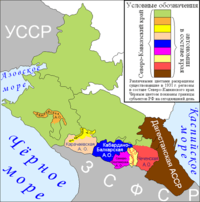North Caucasus Krai

North Caucasus Krai (Russian: Се́веро-Кавка́зский край) was an administrative division (krai) within the Russian Soviet Federative Socialist Republic of the Soviet Union. It was established on 17 October 1924. Its administrative center was Rostov-on-Don until 10 January 1934, Pyatigorsk until January 1936, then Ordzhonikidze (today Vladikavkaz) and, from 15 December 1936, Voroshilovsk (today Stavropol).
As of 1932 population of krai estimated as 10,290,000 in an area of 351,800 km2. 45.9% of the overall population was Russians, and 37.2% of the overall population was Ukrainians.
Widespread death by starvation occurred in this krai during the Soviet famine of 1932–33.
As of the 1937 All-Union Census, the krai had population of 1,635,277 in a smaller territory.[1]
After undergoing numerous administrative changes including the loss of the majority of its territory to a new Azov-Black Sea Krai on 10 January 1934, it was renamed Ordzhonikidze Krai (Орджоникидзевский край), after Sergo Ordzhonikidze, on 13 March 1937, and Stavropol Krai on 12 January 1943.
Currently, since January 19, 2010, this region was divided between the North Caucasian Federal District and the Southern Federal District.